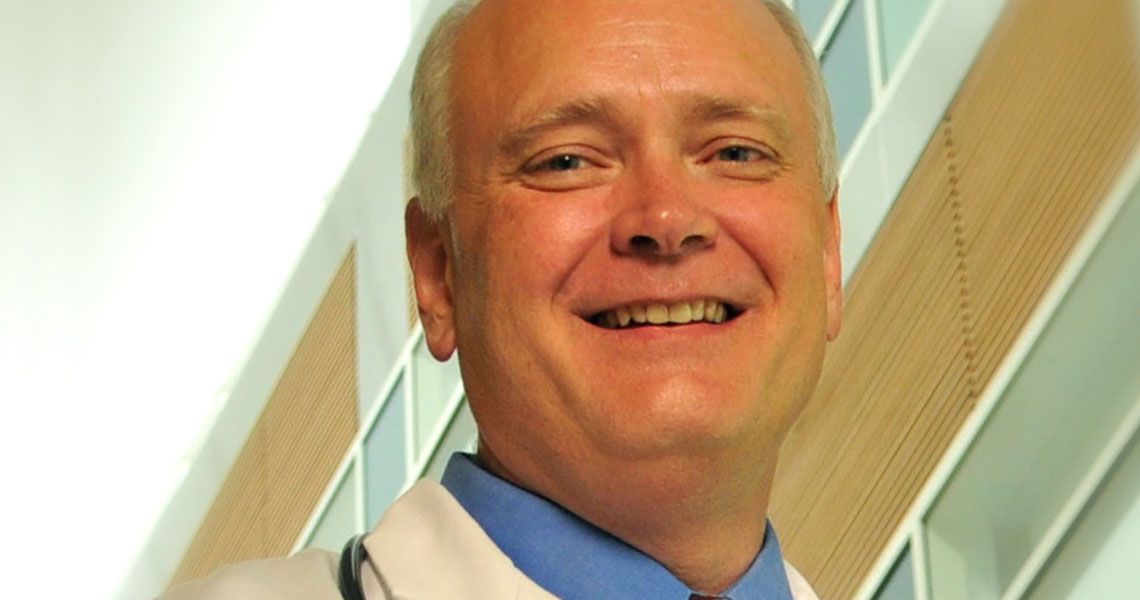The big day is fast approaching and all of the planning and preparation is finally coming to fruition. Not long ago, in the spring of 2011, Hal Jenson, M.D. ’79, was introduced to a crowd of university and community leaders in Kalamazoo, Mich. Soon he will stand before many of those same people as he welcomes the inaugural class of Western Michigan University Homer Stryker M.D. School of Medicine, as the institution’s founding dean.
In just three years Jenson, a GW School of Medicine and Health Sciences (SMHS) alumnus, led Western Michigan’s medical school from concept to reality. It may seem like a brief period, but for Jenson it was a task for which he has been preparing for a very long time.
“I’ve had the benefit of witnessing academic medicine throughout the various levels of my career,” he says. “I’ve been a basic science researcher, a clinical researcher, and I have been continuously involved with medical education and teaching medical students and residents throughout my career. All of those experiences come together when setting up a new medical school.”
Jenson, a pediatrician who specializes in clinical infectious diseases and virology, was selected from a pool of more than 60 applicants. Prior to his appointment, he served as professor of pediatrics and regional dean of the western campus of Tufts University School of Medicine in Springfield, Mass. For nearly a decade, Jenson has been integrally involved in the National Resident Matching Program and currently serves as the organization’s president. But Jenson would argue that his experience in academic medicine goes back much further than that.
“I think SMHS was a great springboard for all that I’ve been able to accomplish so far in my career,” he says. “It gave me a great breadth and perspective for medicine.”
From the Ground Up
It’s an intriguing opportunity, Jenson says, having the chance to put one’s stamp on a school from its inception. “It has the advantage of being able to start from scratch.” It has the disadvantage, he cautions, “of having to start EVERYTHING from scratch.”
Maybe starting from scratch is overstating things a bit, he says, stepping back from his hyperbole. Although Jenson lacked many of the most rudimentary trappings of employment, such as an address or telephone number when he arrived on the Kalamazoo campus, he did have a wealth of support and resources from the local community. The two local teaching hospitals, Borgess Medical Center and Bronson Methodist Hospital, have provided third- and fourth-year medical student rotations as well as graduate medical education for decades. Along with Western Michigan University, the three organizations collaborated to create the medical school. Those advantages alone might be enough to make him the envy of many medical school deans, but Jenson had an even bigger asset awaiting his arrival. As Jenson was introduced as the inaugural dean, the medical school announced receipt of the largest cash gift to a college or university in Michigan history — $100 million.
Building upon the Foundation
The first task in creating a medical school is to map out the process at the highest level, establishing the emphasis and direction of the institution. With a new medical school, says Jenson, there is an opportunity to create a curriculum that benefits from more than a century of U.S. medical tradition and experience, while also incorporating the latest pedagogy.
“We decided very early on that we were going to take a fresh look at the curriculum and how we train medical students,” he says, adding that the school’s curriculum will feature early introduction of clinical training and an emphasis on interprofessional medical teams and new technologies. Humanism is also an element that promises to play a key role, something that’s been part of Jenson’s ideals since the earliest days of his medical career.
“My GW education instilled those humanistic values that we all seek in our physicians,” says Jenson. In many ways, he adds that while matters of professionalism and humanism have become more prominent topics in medical education circles today, those values were ever-present in SMHS culture when Jenson was a student. “They may not have had a formal designation, but those principles, which really are the underpinning of medicine, were instilled very deeply at GW.”
Throughout the process, Jenson found himself balancing a thousand things at once — some larger than others — with many things happening in parallel. Jenson and his leadership team are also overseeing a $68 million transformation of the institution’s 350,000-square-foot home, with a grand opening on Sept. 18, 2014. Between 2012 and 2013, they hired about 80 new administrators and faculty members. With that number of people working together, it’s like being the conductor of an orchestra and paying attention to each section and getting everything to be harmonious.
The team also filled out the school’s clinical and basic science faculty, and established the countless policies and protocols that go into recruiting, selecting, and admitting the 54-person class of medical students. Fortunately, says Jenson, medicine still draws the very best and brightest, and even a new medical school can attract an outstanding class of students. According to the Association of American Medical Colleges, there are more than 48,000 applicants for the roughly 20,000 medical school spots. Jenson confirmed that Western Michigan enjoyed a very competitive recruitment process and filled its available spots with outstanding students.
“I am very optimistic not only about our new medical students, but also about all of the students going into medicine across the country,” says Jenson. “Medicine is a field that values serving people and communities, and those are still values that attract great individuals to the profession.”



